Role of cortical cell type and morphology in subthreshold and suprathreshold uniform electric field stimulation in vitro
- PMID: 20161507
- PMCID: PMC2797131
- DOI: 10.1016/j.brs.2009.03.007
Role of cortical cell type and morphology in subthreshold and suprathreshold uniform electric field stimulation in vitro
Abstract
Background: The neocortex is the most common target of subdural electrotherapy and noninvasive brain stimulation modalities, including transcranial magnetic stimulation (TMS) and transcranial current simulation (TCS). Specific neuronal elements targeted by cortical stimulation are considered to underlie therapeutic effects, but the exact cell type(s) affected by these methods remains poorly understood.
Objective: We determined whether neuronal morphology or cell type predicted responses to subthreshold and suprathreshold uniform electric fields.
Methods: We characterized the effects of subthreshold and suprathreshold electrical stimulation on identified cortical neurons in vitro. Uniform electric fields were applied to rat motor cortex brain slices, while recording from interneurons and pyramidal cells across cortical layers, using a whole-cell patch clamp. Neuron morphology was reconstructed after intracellular dialysis of biocytin. Based solely on volume-weighted morphology, we developed a parsimonious model of neuronal soma polarization by subthreshold electric fields.
Results: We found that neuronal morphology correlated with somatic subthreshold polarization. Based on neuronal morphology, we predict layer V pyramidal neuronal soma to be individually the most sensitive to polarization by optimally oriented subthreshold fields. Suprathreshold electric field action potential threshold was shown to reflect both direct cell polarization and synaptic (network) activation. Layer V/VI neuron absolute electric field action potential thresholds were lower than layer II/III pyramidal neurons and interneurons. Compared with somatic current injection, electric fields promoted burst firing and modulated action potential firing times.
Conclusions: We present experimental data indicating that cortical neuron morphology relative to electric fields and cortical cell type are factors in determining sensitivity to sub- and supra-threshold brain stimulation.
Figures
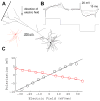
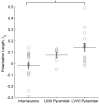
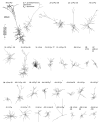
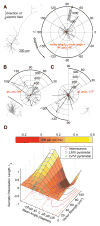
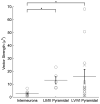

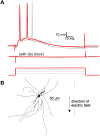

Similar articles
-
One-dimensional representation of a neuron in a uniform electric field.Annu Int Conf IEEE Eng Med Biol Soc. 2009;2009:6481-4. doi: 10.1109/IEMBS.2009.5333586. Annu Int Conf IEEE Eng Med Biol Soc. 2009. PMID: 19964438 Free PMC article.
-
Removal of GABAergic inhibition alters subthreshold input in neurons in forepaw barrel subfield (FBS) in rat first somatosensory cortex (SI) after digit stimulation.Exp Brain Res. 2002 Aug;145(4):411-28. doi: 10.1007/s00221-002-1124-7. Epub 2002 Jul 3. Exp Brain Res. 2002. PMID: 12172653
-
Simultaneously Excitatory and Inhibitory Effects of Transcranial Alternating Current Stimulation Revealed Using Selective Pulse-Train Stimulation in the Rat Motor Cortex.J Neurosci. 2017 Sep 27;37(39):9389-9402. doi: 10.1523/JNEUROSCI.1390-17.2017. Epub 2017 Aug 28. J Neurosci. 2017. PMID: 28847809 Free PMC article.
-
Towards the classification of subpopulations of layer V pyramidal projection neurons.Neurosci Res. 2006 Jun;55(2):105-15. doi: 10.1016/j.neures.2006.02.008. Epub 2006 Mar 15. Neurosci Res. 2006. PMID: 16542744 Review.
-
Direct electrical stimulation of human cortex - the gold standard for mapping brain functions?Nat Rev Neurosci. 2011 Nov 30;13(1):63-70. doi: 10.1038/nrn3140. Nat Rev Neurosci. 2011. PMID: 22127300 Review.
Cited by
-
Transcranial random noise stimulation-induced plasticity is NMDA-receptor independent but sodium-channel blocker and benzodiazepines sensitive.Front Neurosci. 2015 Apr 10;9:125. doi: 10.3389/fnins.2015.00125. eCollection 2015. Front Neurosci. 2015. PMID: 25914617 Free PMC article.
-
The response of L5 pyramidal neurons of the PFC to magnetic stimulation from a micro-coil.Annu Int Conf IEEE Eng Med Biol Soc. 2014;2014:6125-8. doi: 10.1109/EMBC.2014.6945027. Annu Int Conf IEEE Eng Med Biol Soc. 2014. PMID: 25571395 Free PMC article.
-
Repetitive Transcranial Direct Current Stimulation Induced Excitability Changes of Primary Visual Cortex and Visual Learning Effects-A Pilot Study.Front Behav Neurosci. 2016 Jun 3;10:116. doi: 10.3389/fnbeh.2016.00116. eCollection 2016. Front Behav Neurosci. 2016. PMID: 27375452 Free PMC article.
-
Is effect of transcranial direct current stimulation on visuomotor coordination dependent on task difficulty?Neural Regen Res. 2015 Mar;10(3):463-6. doi: 10.4103/1673-5374.153697. Neural Regen Res. 2015. PMID: 25878597 Free PMC article.
-
Effect of transcranial direct current stimulation (tDCS) on MMN-indexed auditory discrimination: a pilot study.J Neural Transm (Vienna). 2015 Aug;122(8):1175-85. doi: 10.1007/s00702-015-1365-9. Epub 2015 Jan 25. J Neural Transm (Vienna). 2015. PMID: 25618566
References
-
- Liebetanz D, et al. Anticonvulsant effects of transcranial direct-current stimulation (tDCS) in the rat cortical ramp model of focal epilepsy. Epilepsia. 2006;47(7):1216–24. - PubMed
-
- George MS, Lisanby SH, Sackeim HA. Transcranial magnetic stimulation: applications in neuropsychiatry. Arch Gen Psychiatry. 1999;56(4):300–11. - PubMed
-
- Avery DH, et al. A controlled study of repetitive transcranial magnetic stimulation in medication-resistant major depression. Biol Psychiatry. 2006;59(2):187–94. - PubMed
-
- Boggio PS, et al. Effects of transcranial direct current stimulation on working memory in patients with Parkinson’s disease. J Neurol Sci. 2006;249(1):31–8. - PubMed
Publication types
MeSH terms
Grants and funding
LinkOut - more resources
Full Text Sources
Other Literature Sources
Miscellaneous

